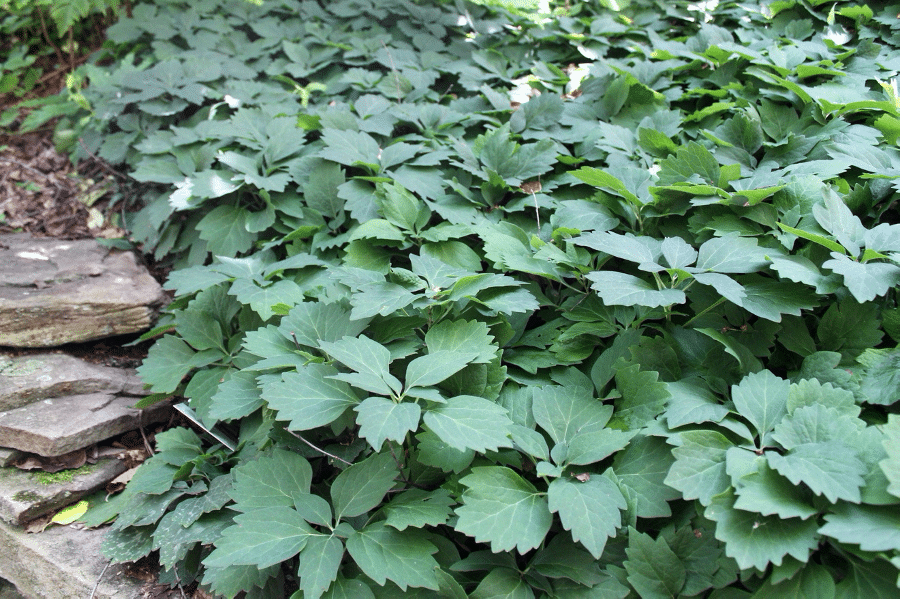5 Unsung groundcovers for your garden

In a perfect garden (if there were such a thing) there would be no mulch to be seen as all gaps would be filled with groundcover and other non-invasive vegetation.
In today’s world, being short leads to a high probability of being overlooked. “Yeah, Garry! You’re finally beginning to work on your long-promised memoir!” some may say. True, I don’t need to clean the top of our fridge as often as some but my vertical challenges are not what this writing is about. Today’s goal is to bring to your attention 5 excellent groundcovers for your garden that are rarely on anyone’s radar.
First, a word about groundcovers. What, exactly, is such a plant? Simply put, these are a category of low plants that when installed in mass, cover the ground. Not exactly rocket science. What may be debated is how tall can a groundcover be. This is a bit subjective but most of these plants tend to be 12” or less. If you get most of your plants at the big box garden centers (shame on you), the most common example (and therefore one I tend to avoid) is the ubiquitous blue rug juniper. These guys are everywhere and they’re not as low maintenance as you may think.
For this writing, let’s expand that list a bit and allow any well-behaved* plant under 2’ to join the fun. “Why the asterisk?” you may askerisk? As we’re on the subject of plants that will cover the ground, there are a few I would lump into the same category with dirty words you should never utter around grandma. These include: English ivy, periwinkle (both Vinca minor and Vinca major), and any other invasive species that can and likely would blanket your neighborhood if left unchecked. Whew! Looks like I’ve just touched on a topic for another writing.
So, back to our unsung heroes. Here are 5 of my favorites in no particular order:

Creeping St. John’s Wort – Hypericum calycinum
Some growers also call this Aaron’s Beard but I’ve always used the common name Creeping Hypericum. This is why common names are so misleading. This tough little groundcover loves dryer, sandy soils but can do pretty well in anything besides heavy, wet clay. It grows to around 12-18” and is a zone 5-9 plant with yellow blooms during July and August. I’ve used this in some parking lot islands at our church and it’s been a champ. Since this one blooms on new growth, you might want to give it a big haircut every few years to promote new growth and kind of rejuvenate it. It can be a bit aggressive and is considered invasive in Oregon but in Tennessee, I’ve not seen it become a problem. Maybe because we’ve got other issues like kudzu!

Barrenwort – Epimedium grandiflorum
This zone 5-8 groundcover also has several common names including bishops hat, fairy wings and my favorite, horny goat weed. But I tag it as barrenwort on my designs. There are many varieties if you’re looking for a particular bloom color but this plant is know more for its foliage than its blooms in my opinion. Ours has a feathery yellow bloom in the summer. Epimedium is very easy to divide so you can start with a couple and have many over time. I’ve even taken some of ours and planted for a friend / client nearby when the contractor couldn’t find it locally. In its third year in full sun it is doing just fine. Another bonus is that it’s deer, rabbit, and drought tolerant. It will also do pretty well in shade although you won’t see many blooms. The irony is that its such a tough bugger but somewhat hard to find in retail garden centers.

Mountain mint – Pycnanthemum muticum
This zone 4-8 plant may be somewhat debatable to describe as a groundcover but I tossed in in here because I love it so much. Zone 4-8, full sun to part shade, this plant ranges from 1-3’ and is more in line of a perennial as it kind of melts away during the winter months. It is extremely fragrant and the pollinators absolutely love it! Ours hums with honey bees when it’s blooming during the summer months. It may also be used for cooking and tea.

Dwarf plumbago – Cerotostigma plumbaginoides
Another underused toughie, this zone 5-9 groundcover can get a little wiry but I do love the variety of color it displays as the season progresses. Above right, is the bronzy color it takes on in fall. A nice little plant with blue blooms July – September, this one does best in full sun to part shade and tolerates a variety of soil types.

Native pachysandra or Allegheny spurge – Pachysandra procumbens
You’ve most likely seen it’s relative, Japanese pachysandra but this plant has a bit of a thinner leaf / foliage and gets a little taller at 6-9”. It prefers part shade to shade and soils that are humus rich and a bit acidic. It’s said to be possibly toxic to animals but my experience is that animals are usually smarter than humans and will probably stick with their dog or cat food. It has a creamy white bloom where it gets a bit of sun and is considered semi-evergreen as it may fade a bit during the winter months.
So, there you have it. Some new plants to research, add to your palette and consider for your garden. Not nearly as common as monkey grass, juniper, or ivy but who wants to be common?
Please share and subscribe! https://ahomeforyourgnome.com/
Till next time,
If you see mulch, PLANT!

